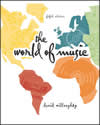|
 |  The World of Music, 5/e David Willoughby
Vocabulary for Listening and Understanding: The Nature of Music
Chapter 2:
| Definitions of music | When exploring the field of music, we find there is no one definition of music. It is difficult to define music without the definer’s own subjective views being a part of the process. Different people define differing sounds and songs as music. Therefore, the book provides no one definitive definition of music.
|  |  |  | | Music as science | The acoustics of sound provide the physical foundation of music as well as the science behind music. The science of music plays a role in the construction of musical instruments, audio equipment, auditoriums, etc.
|  |  |  | | Music as art | Music spans everything from folk art and high art. A lot of music has attributes of both. Great music can be universal appeal and be remembered for generations. A good piece of music encourages repeated listening, performance, and study. It challenges the listener and performer.
|  |  |  | | Silence | Silence is also a part of music. Many classical music composers recognize the importance of silence as a compositional technique with its own aesthetic and dramatic effects, rather than silence being merely a rest from sound.
|  |  |  | | Movement through time | To appreciate music, it is important to remember what happened before and to anticipate what is about to happen. Some music moves forward with energy and momentum, in a predictable progression, to a clear conclusion. Other music may move through time with less noticeable forward energy.
|  |  |  | | Expressive quality | Music has the power to suggest feelings and images, and people have the capacity to respond aesthetically to these suggestions. Music also is a vehicle for expressive statements-statements in which people can convey a wide range of their own feelings through music, from simple children’s songs to highly developed art songs.
|  |  |  | | Artistic quality | Music spans everything from folk art and high art. A lot of music has attributes of both. Great music can be universal appeal and be remembered for generations. A good piece of music encourages repeated listening, performance, and study. It challenges the listener and performer.
|  |  |  | | Functional quality | Music is functional, serving nonmusical purposes which can be ceremonial, therapeutic, or religious.
|  |  |  | | Universality | Music exists in all nations and among all people and has existed as far back in time as we know about people and their cultures. All cultures have music because of its universal power to stimulate emotional responses and to convey powerful feelings, moods, images, and associations. It also provides a means of communication for people who desire a common identity and who have common values and aspirations.
|  |  |  | | Psychological aspects | Music is able to move the mind, heart, and body in many ways. It stimulates responses ranging from excitement to boredom, from love to hate, and from intense involvement to apathetic detachment. Music can affect and change people’s feelings and attitudes. Music is used therapeutically to help people who are physically or mentally challenged. Music also functions to make people feel good about being at a particular place or to distract people from pain or other unpleasantness. It is used to affect moods. Music can generate such feelings as joy, sorrow, pain, love, merriment, and spiritual exaltation. It can also stimulate physical reactions, such as foot tapping, yelling, or shouting. It can be romantic and sentimental; it can be simple and beautiful; and it can bring to mind special memories and pleasant associations. It can also evoke unpleasant associations and be harsh and complex, even noisy. It affects our moods by entertaining, enriching, or relaxing us. It can help people escape momentarily from the real world.
|  |  |  | | Creative process | The creative process, whether simple or sophisticated, is the same. The composer chooses elements of sound and organizes them in some way to achieve a desired result. Although music is created by individuals, these individuals are part of a culture and share a particular view with their intended audience. A creator will usually choose elements and organize them in ways that are valued by the culture. The process can be spontaneous, deliberate, notated, loosely controlled with the performer given considerable freedom to make creative choices, or tightly controlled with detailed notation and meticulous instructions that the performer is expected to follow.
|  |  |  | | Performance process | The goals of the performance process is to adhere as closely as possible to the intentions of the creator. Performing has its own creative element, intentional or unintentional. Performers will sometimes interpret a piece of music on the basis of deliberate choices; but at other times they will follow their musical instincts. A performer’s interpretation brings life to a composer’s symbolism and increases the communicative power of the music.
|  |  |  | | Listening process | - This process can be either passive or active. Active listening requires commitment, energy, and a desire to become personally and intensely involved. Active listening is the most important of developing an appreciation of any type of music.
|
|
|



 2003 McGraw-Hill Higher Education
2003 McGraw-Hill Higher Education